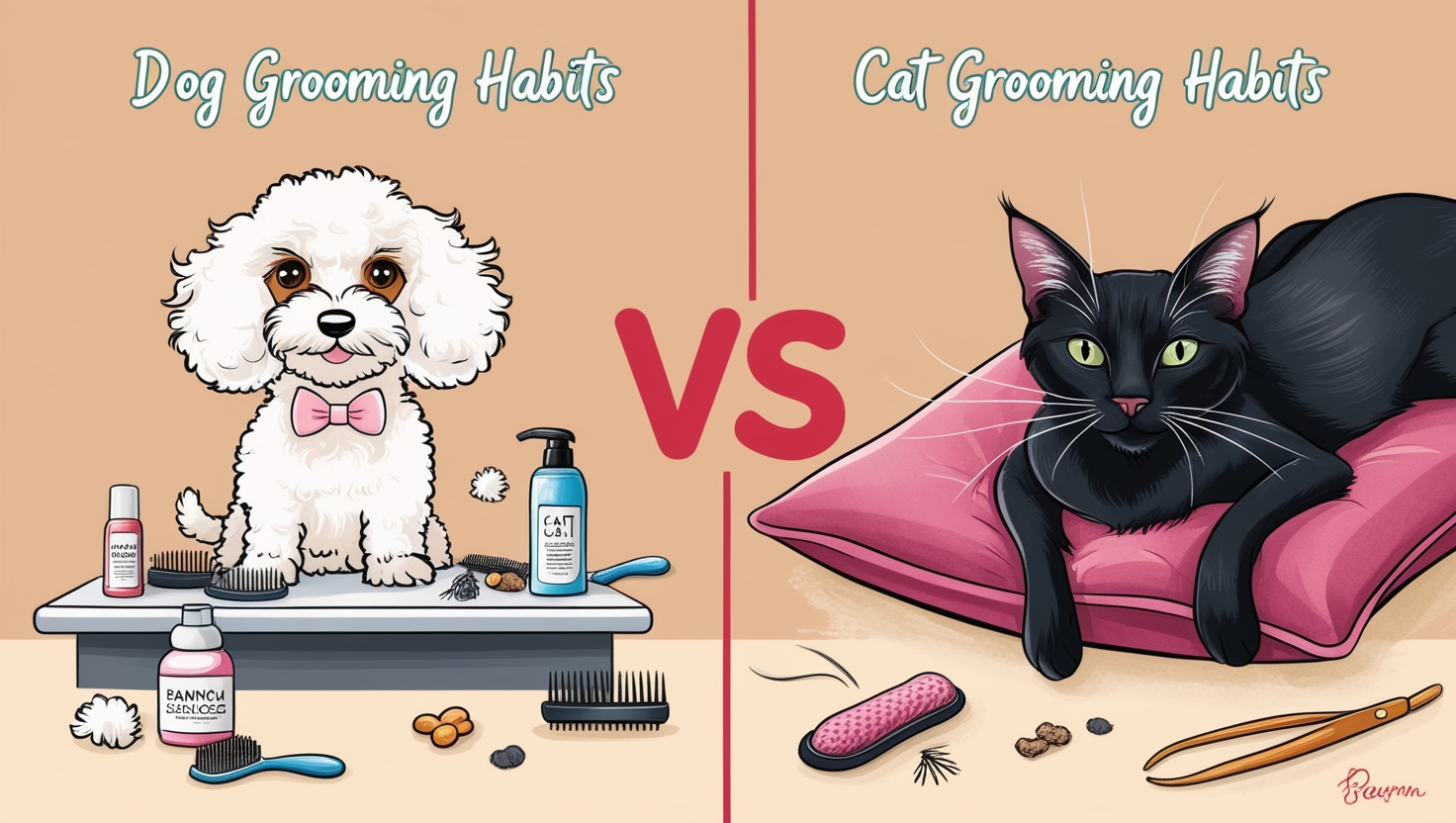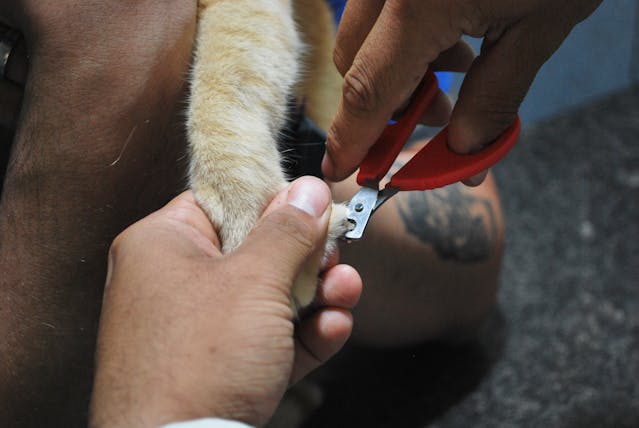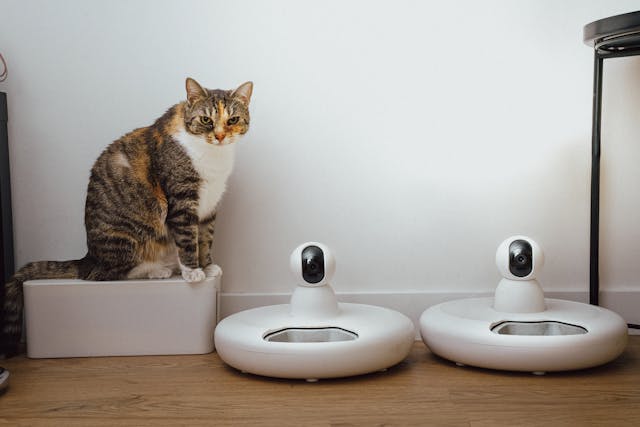Pet grooming is such a crucial part of pet care that will have an impact on the general well being of your furry friend. Grooming habits of cats and dogs are different. So it will be appreciated by the pet owners by understanding the habits of grooming specific to their pet. In this article I jump in to take a look at the differences and similarities in cat grooming vs dog grooming and insights into what makes cats (and dogs) self groom and what they prefer in terms of grooming habits and sensitivities.
Considerably different to each other in their approach to grooming, cats and dogs’ preferences are determined by their evolutionary and lifestyle traits. Each species has self grooming behaviors and grooming tools that speak to the other methods by which the species groom itself. In this comprehensive guide, you are going to learn what is it different about cat grooming habits vs dog grooming habits.
Self-Grooming Behavior
Cats’ Self-Grooming Rituals:
Cats are famous for their grooming habits. They spend so much time cleaning themselves. This behavior serves multiple purposes, including:
- Hygiene: Making the fur dirt and debris free.
- Temperature Regulation: Cooling them down involves saliva being spread on their coats.
- Stress Relief: It can be a soothing thing for cats that set them at ease.
To keep their fur free of loose hair and dirt, cats use their tongues, covered with tiny backward facing barbs called papillae, that scrubs their fur clean. This is not only about cleanliness, this is about this self grooming which distributes natural oils, that naturally keep their coats shiny and healthy.
Dogs’ Grooming Approaches
Dogs, on the other hand, have variable grooming habits that sometimes depend on human intervention. Dogs will lick themselves, but they won’t clean as obsessively as cats. Factors influencing dog grooming include:
- Breed Characteristics: Some breeds of dogs need lots of attention to their coats, while others require only minimal attention.
- Social Behavior: As a part of social bonding with other dogs, dogs may groom other dogs.
Dogs do not have their own brush or are it too difficult to place him in a tub of water that the owners take action.
Sensitivity to Grooming
Cats’ Sensitivity Levels
Grooming can be hard for some cats. Some things are genetic – individual temperament lets you know whether a cat can tolerate being brushed or even enjoy it and others remember to whine. Notable factors affecting their sensitivity include:
- Past Experiences: It is possible that a cat that has had negative experience with being groomed will react defensively.
- Physical Sensitivity: It may be sensitive in areas around the face, paws and tail.
And it pays for cat owners to watch their cats’ reactions to grooming sessions, then adjusting techniques and tools to try and not stress or cause them anxiety.
Dogs’ Grooming Sensitivity
But dogs tend to put up with more grooming, even if sensation levels can differ between breeds and personalities. Factors that influence a dog’s comfort during grooming include:
- Temperament: While many breeds are not hard to groom, some breeds are naturally more adaptable and easy going.
- Socialization: Dogs that are handled and groomed normally as they grow up are less troublesome.
Learning how a dog feels about grooming can make the experience better for both pet and owner.
Bathing Frequency
How Often Should Cats Bathe?
Dogs need baths more frequently than cats. Their self-grooming habits keep them relatively clean, and baths are often unnecessary unless:
- Medical Conditions: Shampoos and baths may be prescribed for some skin conditions.
- Ingestion of Toxins: Sometimes bathing will be necessary if a cat gets into something harmful.
Most healthy cats only need a bath once in a few months.
Bathing Dogs: What You Need to Know
However, dogs may require more frequent baths than this depending on their lifestyle and coat type. Factors affecting bathing frequency include:
- Activity Level: If you have an active dog that gets outside, they will probably need more baths.
- Coat Length: Bathing these long haired breeds more often will be necessary to help with dirt and mats.
On average but depending on an individual they should usually be bathed once in 1 to 3 month’s time.
Nail Trimming Needs
Nail Care for Cats
Although you wouldn’t think it, nail trimming is a very important part of cat grooming and many cats naturally have toe nails wear down naturally. However, regular trimming is necessary to prevent overgrowth, which can lead to:
- Discomfort: Pain and trouble walking can be caused by long nails.
- Injury: If the overgrown claws snag on anything, the result is injury.
Cats nails should be trimmed every 1 – 2 weeks for pet owners.
Nail Care Considerations for Dogs
Without dog nail trimming, your dog can be in pain. Dogs that do not naturally wear down their nails may experience:
- Splayed Toes: Having long nails can even cause the toes to spread, and lead to misalignment.
- Injury Risks: If nails become overgrown, they can break or split and become painful and bleed.
How often do I need to trim my dog’s nails will depend on the level of activity and growth rate of the dog’s nails.
Grooming Tools and Techniques
Cats Grooming Tools are essential.
You need specific cat grooming tools to have a positive experience. Common tools include:
- Brushing Tools: A grooming brush or comb can help pull out loose fur, as well as prevent matting.
- Nail Clippers: It is possible to trim the cat nail safely and easily with specialized cat nail clippers.
- Pet Wipes: Suitable for spot cleaning between baths.
Knowing which tools to use can make going through the grooming process easier on you and the cat.
Grooming Tools for Dogs
Dog grooming also calls for a collection of tools customized to the breed’s grooming needs. Essential tools include:
- Slicker Brushes: Great for getting tangled and loose fur off.
- De-shedding Tools: Great for heavy shedders in need of controlling loose hair.
- Shampoo: It is recommended that you choose a coin iPhone marketed specifically for the kind of the current one you’re using it for device.
By knowing the right tools, people can have a better, more pleasing experience of their cat’s grooming.
Health Considerations
Grooming and Cat Health
Grooming also serves to keep a cat’s coat neat and, as we will see, is an important part of a cat’s overall health. Benefits of grooming include:
- Skin Health: Brushing regularly can detect these skin problems early and take appropriate measures.
- Stress Reduction: Routine grooming such as pats and scratches can help sooth anxious cats helping them feel emotionally well.
Changes in cats coat or skin during grooming sessions should be watched by pet owners for potential underlying health issues.
Impacts of Grooming on Dog Health
Health means dog grooming is equally important. Regular grooming contributes to:
- Early Detection of Health Issues: Grooming sessions, for example, will help check for skin infection, lumps, or fleas.
- Improved Circulation: It stimulates the skin and also improves blood flow.
It’s like with cats, helping your dog groom itself can mean recognizing potential health problems earlier.
Who Cleans Your Dog More Than Your Cat?
Many owners compare cat grooming habits vs. dog grooming habits, gauging one as easier than the other. And this is largely dependent on the temperament and breed attributes of the individual pet.
Comparing Ease of Grooming
- Cats: Cats don’t need help grooming themselves, but if cats aren’t accustomed to or don’t like being groomed this can be a problematic process. And overall their self sufficiency may make them easier to maintain in terms of cleanliness.
- Dogs: Basically, most breeds need more frequent interventions from their owners for the grooming when compared to the breeds with shorter or thinner coats. Some dogs enjoy grooming and are easily managed, but many dogs are more social.
A Look into Why Cats Groom but Not Dogs.
Cats and dogs differ in their grooming behavior because their evolutionary histories and social structures are very different. Cats are solitary hunters, concurring on thing, independence and cleanliness for their survivors. But their grooming habits have been evolved to strengthen their hunting efficiency.
However, dog grooming is entirely their pack oriented nature. Dogs do groom themselves, but in many cases, they also depend on the company of the group and owner support for grooming.
So why is cat grooming more expensive than dog grooming?
Evaluating grooming costs in pets, often pet owners discover that while dog grooming services can be cheaper, cat grooming services can actually be more costly. This discrepancy can be attributed to:
- Specialized Skills: Caring for cats often need more specialized skill because the cats have different temperaments. Especially in terms of handling them.
- Higher Maintenance Breeds: Some cat breeds, most often those with long hair, require more elaborate techniques of grooming, which increase the overall cost.
Both types of grooming can be expensive, but knowing these differences in grooming types can help pet owner’s set-aside money budget-wise.
How Clean Are Cats Compared with Dogs?
Self-grooming is in fact probably one of the reasons cats tend to be perceived as being cleaner than dogs. However, several factors come into play:
Cleanliness Comparison
- Self-Grooming: Grooming is something that cats do a lot of, and it is good for their coat and skin health.
- Behavioral Differences: Dogs will roll in dirt or mud but cats remain clean in order to survive.
So both animals can make clean companions, but because cats are cleaner-brained animals than dogs, they may beat out dogs for perceived cleanness in part because of their grooming behaviors.
Conclusion
To sum it all up, knowing about cat grooming vs dog grooming gives us that insight into how we care for our much loved pets. Cats are their own self grooming beings, but it takes more intervention on the part of humans when it comes to dogs, and breed and temperament determine exactly how much that entails. No two species are exactly alike, and each has its own unique set of needs: ones dictated by biology and lifestyle.
Pet owners learn to recognize the difference and the similarities in the grooming habits of their furry friends, and were able to cater to their grooming needs better, which improves the health and happiness of their water friends. If you want more interesting content about pet care and grooming, don’t hesitate to leave a comment here, or visit some other topics at our website. Happy grooming!





